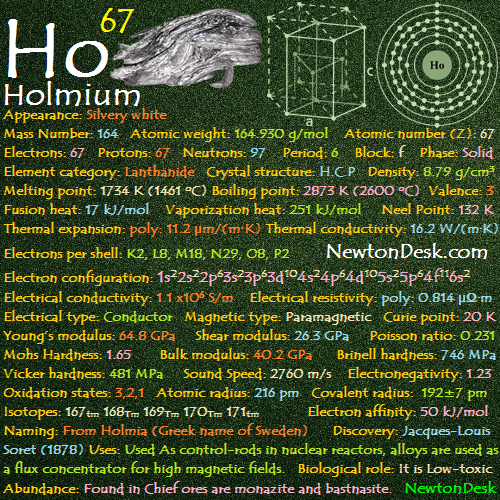90 Th (Thorium)
Appearance: Silvery, often with black tarnish
Atomic weight: 232.0377
Atomic number (Z): 90
Electrons: 90
Protons: 90
Neutrons: 142
Period: 7
Block: f
Element category: Actinide
Electrons per shell: K2, L8, M18, N32, O18, P10, Q2
Electron configuration: 1s22s22p63s23p63d104s24p64d105s25p64f145d106s26p66d27s2
Phase: Solid
Melting point: 2023 K (1750 oC)
Boiling point: 5061 K (4788 oC)
Density: 11.7 g/cm3
Half Life (s): 4.43E+17
Lifetime (s): 6.40E+17
Decay mode: α decay
Neutron cross section (Barns): 7.4
Heat of fusion: 13.81 kJ/mol
Heat of vaporization: 514 kJ/mol
Molar heat capacity: 26.230 J/(mol∙K)
Oxidation states: 4, 3, 2, 1
Ion charge: Th4+
Electronegativity: 1.3
Valence: 4
Ionisation energies: 1st: 587 kJ/mol 2nd: 1110kJ/mol 3rd: 1930 kJ/mol
Atomic radius: 179.8 pm
Covalent radius: 206±6 pm
Crystal structure: Face-centred cubic
Sound Speed (thin rod): 2490 m/s
Thermal expansion: 11 μm/(m∙K)
Thermal conductivity: 54 W/(m∙K)
Electrical resistivity: 157 nΩ.m
Magnetic ordering: Paramagnetic
Volume magnetic susceptibility: 0.0000621
Mass magnetic susceptibility: 53×10-10 m3/kg
Molar magnetic susceptibility: 12.3×10-10 m3/mol
Critical temperature: 1.38 K
Young’s modulus: 79 GPa
Shear modulus: 31 GPa
Bulk modulus: 54 GPa
Poisson ratio: 0.27
Mohs hardness: 3
Molar volume: 19.79 cm3/mol
Vickers hardness: 295-685 MPa
Brinell hardness: 390-1500 MPa
CAS Number: 7440-29-1
Naming: After Thor
Discovery: Jöns Jacob Berzelius (1829)
Isotopes: 227Th 228Th 229Th 230Th 231Th 232Th 234Th
Uses: Thorium is used as an alloying element in magnesium, and to coat tungsten wire used in electronic equipment, and to control the grain size of plutonium used for electric lamps.
Thorium can be used as a source of nuclear power, India and China are in the process of developing nuclear power plants with thorium reactors.
Thorium oxide is added to glass to create glasses with an high refractive index and low dispersion (For use in High-quality camera lenses), Thorium oxide is also used as an industrial catalyst.
Biological role: It is toxic due to its radioactivity
Natural abundance: Thorium is found as the minerals thorite, uranothorite, thorianite and also found in monazite (which is the most important commercial source). Several methods are used to produce the metal, such as reducing thorium oxide with calcium or electrolysis of the fluoride.
World production of thorium exceed 30,00 tones per year.
Abundance 4×10-8%(In Universe), 3×10-8%(In Sun), 3.9×10-6%(In Meteorites), 0.0006%(In Earth crust), 4×10-12%(In Oceans)
#thorium


